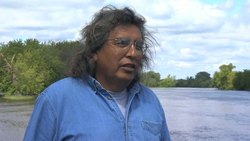Nation-to-Nation
Dakota and Ojibwe people political traditions existed before the rise of the "nation-state" in Europe.

Sites of Tribal Governments
The treaties signed by Indigenous peoples with the U.S. are often described as “nation-to-nation” agreements. “Nation” is a useful word for describing the sovereignty of American Indian groups within the U.S. political system. But the word belongs to a political tradition that started in Europe, and American Indians have their own political traditions.
Even in Europe, the modern concept of the “nation state” developed only in the mid-1600s. It describes those elements of sovereignty that mattered to Europeans at the time: identification with a specific territory, and resistance to interference from outside political forces. American Indian groups enjoy those aspects of sovereignty today on “reservations” (where sovereignty as been “reserved”).
But American Indian sovereignty originates outside the European/U.S. political system, and existed before the U.S. existed. The word “people” is perhaps more appropriate than “nation” to describe in English the collective identity of American Indians. This term emphasizes traditions such as language that are held in common.
Dakota and Ojibwe political traditions are highly democratic. Within the larger groups of Dakota or Ojibwe, smaller or more local groups have always held a high degree of autonomy. (The U.S. often called these smaller groups “bands.”)
- The Dakota are traditionally organized in four groups -- Mdewakanton, Wahpeton, Sisseton, and Wapekute – that are members of the Seven Council Fires (which also include the Yankton, Yanktonai, and Lakota). The U.S. did not sign any treaties with the Dakota as a whole, but with groups such as Mdewakanton and Wahpakoota, Sioux of the Leaf or the Sioux of Wa-ha-shaw’s tribe.
- The Ojibwe were traditionally organized by village; over time, larger entities (such as Chippewa of the Mississippi) emerged. In treaties with the U.S., Ojibwe signers were often identified by the village in which they lived.
The word “nation”, then, applies to American Indian peoples within the context of the U.S. political system. In signing treaties, Dakota, Ojibwe, and other American Indian peoples retained sovereign rights that are recognized within the U.S. political traditions as national rights.
“Dependent national status” is an often-confusing term used to describe the position of the tribal governments in the U.S. political hierarchy. The U.S. Supreme Court used this term to describe two aspects of U.S.-Indian relations:
- In treaties, American Indians often recognized a “controlling interest” of the U.S. over their affairs, ultimately placing tribal governments on the same level as State governments in intergovernmental affairs.
- In exchange for land cessions that destroyed traditional Indigenous ways of the life, the U.S. took on a trust responsibility, promising that American Indians could depend on it for perpetual material support.
“People” or “Nation?”
The term “people” rather than “nation” was used by the U.S. founding fathers in the Declaration of Independence:
“When in the course of human events it becomes necessary for one people to dissolve the political bands which have connected them with another…”






